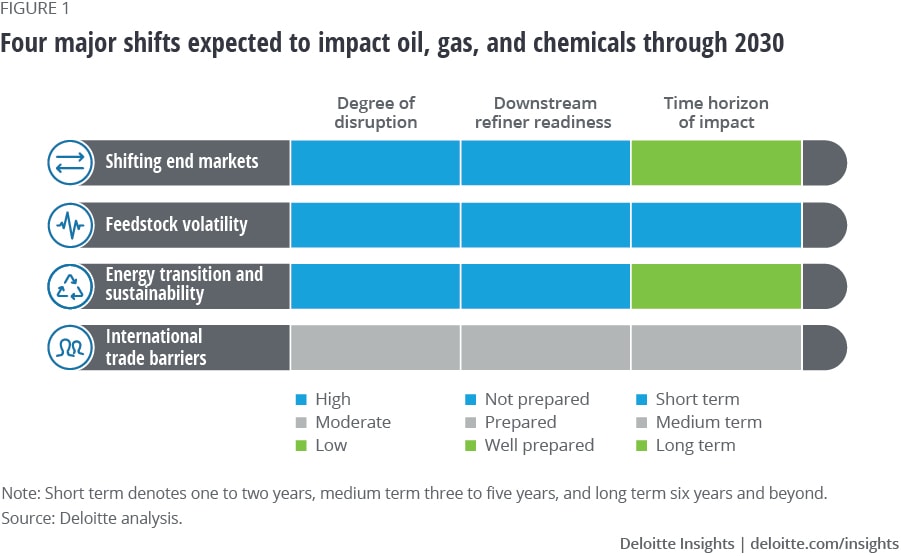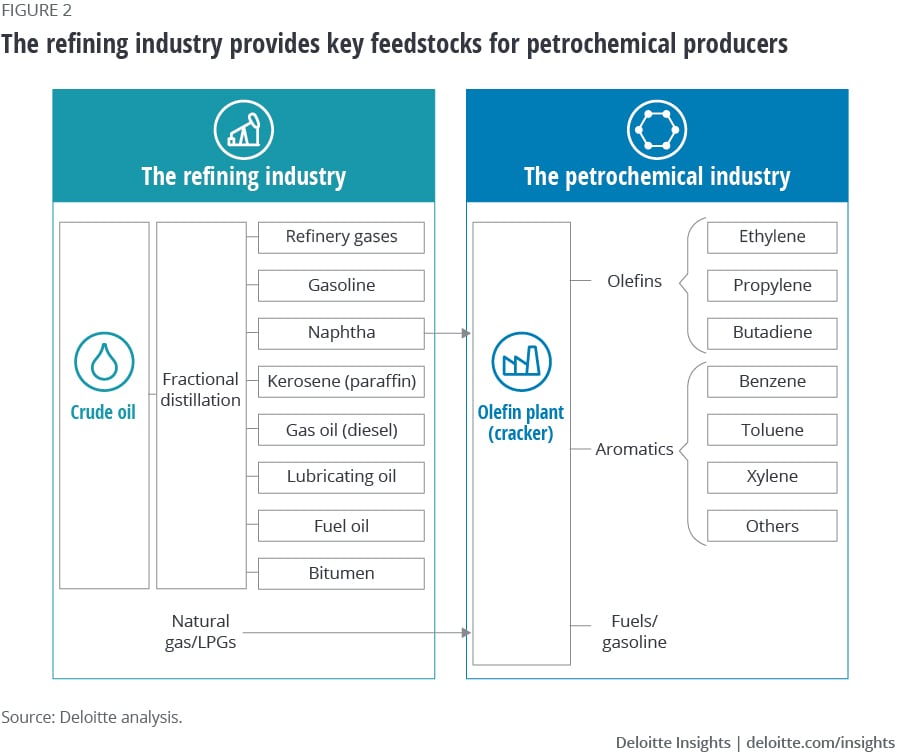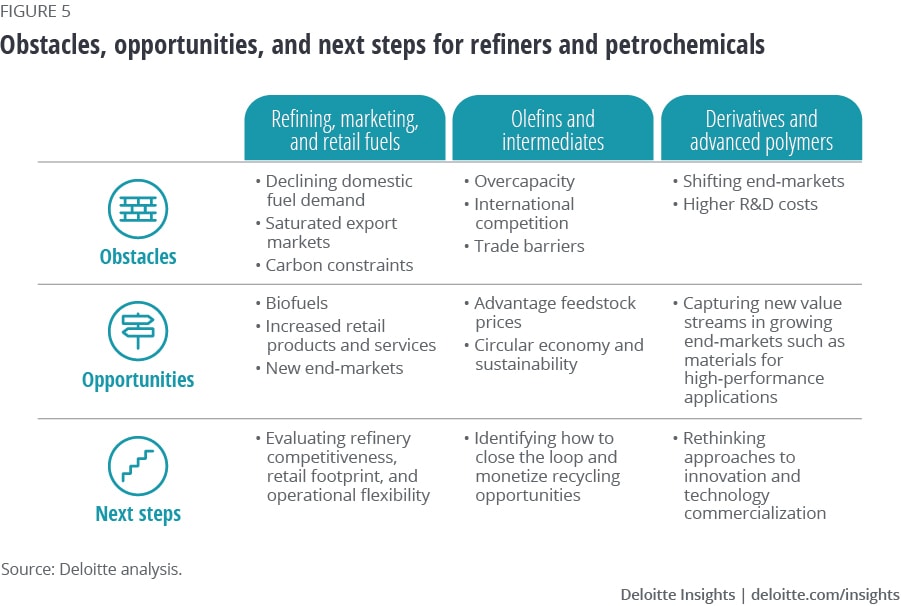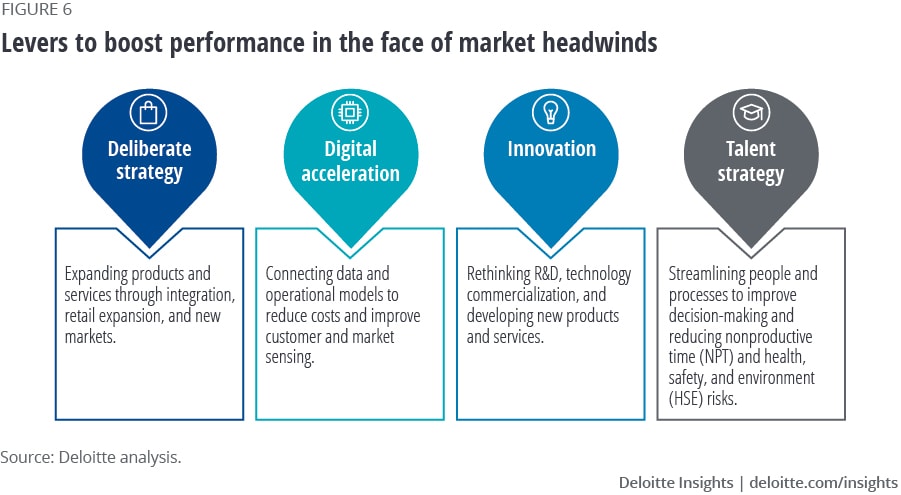
Building resilience in oil, gas, and chemicals Navigating disruption and preparing for new opportunities
14 minute read
26 October 2020
 Duane Dickson United States
Duane Dickson United States Kate Hardin United States
Kate Hardin United States- Aijaz Hussain United States
 Thomas Shattuck United States
Thomas Shattuck United States
Refiners and petrochemical producers should rethink their long-term strategies and value propositions to boost their competitive edge in the face of disruption.
Overcoming industry headwinds and preparing for the next 10 years
2020 has been a year of significant disruption and change—businesses have closed and reopened; working from home has become widespread; and many end-use industries are facing both cyclical and structural pressures. The oil, gas, and chemicals industry has been one of the hardest hit by the pandemic, with energy and industrials revenues declining by 54% and 25%, respectively, primarily because of increased remote work and lower industrial demand for energy and materials.1 Refiners have borne the brunt of the decline in fuel demand, and declining automotive sales and air travel have impacted demand for major petrochemicals and refined products. However, the pandemic has created new opportunities for the chemicals industry, increasing demand for single-use packaging as well as for materials used by the life science and electronics industries. Recovery has been uneven. Vehicle sales fell 50% in April before rebounding over the summer—they still remain 15% below 2019 levels.2 Additionally, after plunging close to 80%, the number of commercial flights has partially rebounded—though it’s still down 30% compared to pre–COVID-19 levels.3
Learn more
Explore the Building resilience in oil, gas, and chemicals collection
Browse the Oil, gas & chemicals collection
Learn about Deloitte’s services
Go straight to smart. Get the Deloitte Insights app
There are long-term challenges on the horizon. Over the next 10 years, refiners and petrochemical producers are expected to face significant disruptions from various sources. Many of these disruptions could be long-term shifts that reshape the energy landscape both in the United States and internationally. Some of them are shifting end markets, feedstock differentials, the energy transition, and international trade barriers, including tariffs (figure 1).

These shifts will likely not have the same impact across the entire value chain despite the interconnection between refining and petrochemicals (figure 2). However, there are several commonalities. For example, while both US refining and petrochemicals face challenges from excess capacity, tariffs have not impacted the refined products trade as much as they have impacted many chemical feedstocks, with fuels primarily being exported to Latin America. The opposite is true for plastics and many other petrochemical products that are exported to Asian markets.4 Conversely, the energy transition could negatively impact refiners by reducing fossil fuel demand, but it could create opportunities for chemical producers by raising demand for lightweight plastics and advanced materials needed in electric vehicles (EVs).

What this means is companies ranging from independent refiners and fuel retailers to integrated downstream petrochemical producers may need to rethink their long-term strategies and value propositions to boost their competitive edge in the face of these four major shifts. These companies should consider the following four levers to outperform:
- Developing deliberate strategies based on their opportunities to expand the scale and scope of their operations.
- Accelerating investment in and deployment of digital technologies to increase agility and lower costs.
- Innovating and improving new technology commercialization.
- Preparing the workforce for the challenges of tomorrow through continuous training and upskilling.
Sharp contraction followed by a protracted recovery from COVID-19
While commodity markets are often unpredictable, COVID-19 has created unprecedented price and demand volatility.5 Both US refiners and petrochemical producers’ revenue and earnings before interest, taxes, depreciation, and amortization (EBITDA) are projected to fall in 2020 following the spread of the pandemic (figures 3 and 4). Prior to 2020, the two industries were operating at two different speeds: Following the 2014 oil price crash, refiners saw relatively favorable market conditions with lower feedstock costs and rising demand, but excess petrochemicals capacity led to weakening margins that partially offset the feedstock advantage from US natural gas liquids (NGLs) over the same period.


Following sharp contraction in demand in 2020, both industries faced short-term overcapacity and low product prices. Refiner earnings rebounded in the second quarter as oil prices fell, reducing input costs—though margins are projected to remain compressed relative to pre-2020 levels because of the anemic fuels market. The same was true for petrochemical producers that primarily use naphtha as a feedstock. But for many US petrochemicals companies—most of whom primarily use NGLs as feedstock—neither sales nor profits have recovered so far in 2020, in part due to the continued cyclical pressure on key end markets combined with preexisting market weakness. Margins will also likely be compressed for US petrochemicals producers, albeit possibly more modestly than for refiners, until industrial activity increases. Both industries’ revenue and EBITDA are expected to partially recover as economic conditions improve but will likely remain below 2019 levels through 2022.
Both industries have seen a dramatic drop in utilization. For refiners, the drop was driven by lower demand for gasoline and jet fuel, with yields shifting to produce disproportionately more distillate. Though diesel demand has declined modestly too, it has proven more robust than other fuels. In the case of petrochemicals producers, cyclical overcapacity combined with the rapid drop in industrial activity because of COVID-19 has led to the perfect storm—impacting net income more than revenue with sharply compressed margins. Petrochemical overcapacity will likely prove self-correcting as new ethylene investment slows. In the near term, production and capital investments will be cut and construction of new petrochemical plants will be deferred. However, refiners may have less room to maneuver because demand for fuels is projected to grow slowly over the next decade and fuels represent more than 80% of US refinery production. The rest is composed of naphtha, lubricants, waxes, as well as petroleum coke and other heavy residual products.6
The medium path to recovery is uncertain, with a range of alternative indicators sending mixed signals. While spending and activity levels have improved, others such as the number of commercial flights and volume of retail foot traffic remain well below pre–COVID-19 levels. Moreover, if second and third waves of the pandemic spread across not only the United States, but also key export markets in Latin America, Europe, and Asia, demand growth for petroleum-derived products could be anemic, if not negative. This could be particularly true for jet fuel and materials used in the aviation industry, which is expected to not fully recover even in the next few years. The International Air Transport Association projects that air travel could remain 30–40% below pre–COVID-19 levels even in 2021.7 Additionally, deliveries of new planes dropped 50% in 2020, and passenger air traffic could take up to five years to recover—though there are green shoots in countries such as China that have contained the virus.8
The first half of 2020 has been challenging for refiners and petrochemicals producers and the second half and much of 2021 are expected to be a period of shoring up balance sheets and preparing for recovery. However, the path to recovery may diverge substantially across different products and regions. Price and supply volatility will likely continue as the US and global economies try to find a new equilibrium in an ongoing and post–COVID-19 world.
Major shifts will impact end markets, product demand, and trade in 2020s
Following the recovery of the broader economy and the oil, gas, and chemicals industry, companies will need to tackle longer-term challenges—particularly as sources of demand shift or decline and the global market continues to evolve. Over the last 10 years, refiners and petrochemical companies have invested in new capacity and reaching new markets, but market conditions over the next 10 years will likely look different from the last decade. US refining capacity has grown 7% since 2010 and domestic ethylene production capacity has almost doubled. The 2020s will likely be marked by lower demand growth and require a different approach.9
Despite the obstacles—ranging from rising capacity and declining demand to trade barriers and saturated export markets—there are also several opportunities for refiners and petrochemicals companies to pursue growth (figure 5). Companies may need to rethink their business models to better match not only shorter-term volatility but also the major shifts in the fuels and petrochemical markets. There are three major, long-term changes that these companies should address across the entire value chain: Shifting end markets, the impacts of the energy transition and sustainability, and international trade barriers.

Refiners are facing structural fuel demand declines. If EV adoption increases and fuel efficiency regulations tighten, fuel demand in the United States will likely grow slowly, or potentially even shrink, over the coming decade. Increased petrochemical integration could shift yields toward feedstocks with longer-term growth opportunities. Declining gasoline demand could lead to higher production of NGLs and other chemical feedstocks, increasing the advantages of further integration. However, at present the United States is grappling with overcapacity in ethylene and other commodity chemicals production.
The energy transition poses risks to traditional product and service lines, but it also creates demand for sustainable fuels and products. Alternative fuels may provide longer-term growth. However, the existing production capacity is limited, and markets are currently driven by government incentives and carbon regulations—injecting political uncertainty into what could prove to be a bright spot for refiners. Refiners might need to reposition their refining and retail portfolios to better match a market where demand for their key products is uncertain.
For petrochemicals producers, shifting end markets could provide an opportunity to diversify into higher value–added products. Major end markets such as automotive, aerospace, and construction are all being disrupted by both short-term cyclical trends as well as long-term secular shifts. While EVs pose a threat to fuel consumption for refiners, they could create new demand for high-performance and low-weight plastics—as the average plastic content in an automobile still stands below 10%.10 Moreover, the push to create more sustainable products will likely require the development of recycling capacity and new, lower-impact chemicals. This could be a double-edged sword because higher recycled materials will likely coincide with reduced demand for virgin materials, at least in US domestic markets. For both industries, domestic demand growth could prove challenging—even if companies develop products with low environmental impact.
For petrochemicals producers, shifting end markets could provide an opportunity to diversify into higher value-added products.
Export markets have been a source of growth for many oil, gas, and chemical companies, with rising demand in the developing world providing new markets for US products. But increasing future exports could prove more challenging. Over the past 10 years, domestic companies have increased exports and entered new markets following the shale boom. For oil and gas companies, the rapid increase in production, combined with a more mature domestic economy, led to exporting of oil, natural gas, and refined products, often to nearby Latin American markets. US total petroleum exports have increased by a factor of eight since the beginning of the mid-2000s—with refined products comprising almost 40% of 2020 export volumes.11 Saturation in major markets such as Mexico could blunt export growth, and tariffs and trade disputes could limit shipments to fast-growing economies in Asia, such as China, India, and Vietnam. These countries have imported less than 10,000 barrels per day of gasoline, distillate, and jet fuel combined from the United States over the last five years.12
Tariffs and trade issues have been more problematic for petrochemical producers. The ongoing trade dispute between the United States and China has imposed an element of unpredictability to international demand for domestic products. Tariffs reduce the advantage of US companies’ lower-cost feedstocks, and access issues have reduced Chinese demand for US plastics. Over the next decade, Chinese polyethylene demand is projected to increase by 20 million tons to more than 530 million tons. Demand for other petrochemical products is expected to grow rapidly as well. With excess capacity weighing on the US industry, reduced export opportunities are expected to both exacerbate short-term price and volume volatility as well as restrict longer-term growth potential.13
The lack of access to exports markets will likely become a bigger issue for US companies as potentially declining domestic demand and trade uncertainty will likely reduce oil, gas, and chemicals investment in the United States if companies can’t find new growth opportunities. Refineries, fuel distribution and retail networks, and chemical production capacity require substantial capital investment and often take years to fully develop. Shifting long-term end-market demand, combined with regulatory challenges and cost overruns, can erode project economics. While COVID-19 may reduce spending over the next few years, these longer-term shifts could restrict investment through the 2020s. This is doubly true for integrated refining and petrochemical plants which face challenges across several feedstocks and products.
Opportunities for refiners and petrochemical producers to outperform
Both refiners and petrochemical producers are facing similar headwinds and have multiple levers—such as deliberate strategy, digital acceleration, innovation, and talent strategy (figure 6)—that they can use to overcome both short- and long-term challenges.

Deliberate strategy
Differentiation can be challenging for companies in commoditized markets such as transport fuels and bulk chemicals. Expanding capacity and increasing refinery petrochemical plant integration can increase economies of scale by leveraging synergies between the two, but it is not a panacea. Both industries are facing compressed margins with limited room to increase sales volumes or product prices—though a more disciplined pricing strategy and stronger customer relationships can help increase pricing in even commoditized markets. For those with independent refining or petrochemical assets, the integration may not make sense in the short term or, possibly, even in the long term. Companies should reassess what they produce and how they access key end markets.
A key challenge for petrochemicals producers will be evaluating potential demand growth—or decline—scenarios for multiple end markets and building out their productive and marketing capacity. While volatility will likely remain, diversifying product offerings to include lower-carbon, recyclable, and more advanced materials can help reduce market risks and create higher value–added business opportunities.
Refiners and petrochemicals companies could face a similar question of what to prioritize as they build or adapt their market presence, particularly as new competitors enter the space. Diversification through alternative fuel production and distribution could help position refiners and retail businesses as sustainable companies. Furthermore, these companies can also use their existing customer touchpoints—retail gas stations—to better differentiate their brands as being high-end or economical. They can also boost margins on fuels and create opportunities to sell new products and services based on accessibility, convenience, and new technologies in transport-adjacent industries such as delivery.
Digital acceleration
The oil, gas, and chemicals industry has always been a mixture of both high- and low-tech approaches, ranging from computer-controlled plant operations to manually managing, forecasting, and planning inventories. Digitalization is not new in the sector, but low-cost sensors, increased computing power, and sophisticated software are enabling companies to take a more holistic approach to automating their operations. This helps create more proactive businesses that can leverage market sensing and customer data. For example, the Internet-of-Things (IoT) can help refining and petrochemical manufacturers to automate key chemical engineering processes, integrate machines, monitor performance, and predict equipment failure. Moreover, combining IoT and predictive analytics can enable track-and-trace capabilities leading to fine-tuning of production yields when combined with consumer market sensing data.
Moreover, the industry can take advantage of the more widespread availability of digital tools to not only better predict customer demand, but also to manage inventory, analyze procurement and hedging strategies, and better connect their operational and economic models. This can help companies incrementally increase margins, reduce supply risks, and improve customer engagement and experience, thereby creating a more intelligent approach to planning, optimization, and sales strategy. Digitalizing helps cut costs and can increase agility, enabling companies to flex their operations to rapidly adapt to changing circumstances such as those following the spread of COVID-19.
Innovation
Innovation can help drive long-term revenue growth, but companies should rethink how they commercialize new technologies in the 2020s. Consumers, investors, and regulators increasingly expect lower-carbon and sustainable products and services, and both refiners and petrochemical companies would need to adapt. For petrochemical producers, this will likely link to their long-term strategy of diversifying output and reaching new end markets. For refiners and fuel retailers, the path could be more treacherous—increasing demand for alternative fuels will likely come at the expense of gasoline and diesel fuel sales in many markets while necessitating costly refinery conversions. For both, however, innovation might be critical because existing market conditions are challenging and will likely remain so over the coming decade. Leveraging customer touchpoints to inform decision-making can help close the gap between innovation and commercialization. As the oil, gas, and chemicals industry continues to change, rethinking innovation may not be optional. For example, value is migrating from the traditional R&D departments of chemical companies to material informatics platforms. Until now, the process of discovering and developing new chemicals has remained largely unchanged and primarily laboratory-based. This made it difficult to predict the behaviors of materials under new conditions and required many lab experiments, which were frequently expensive, unproductive, and time-consuming. The same will likely prove true for refiners as they push to commercialize new lower-carbon fuels including not just biofuels, but potentially hydrogen as well.
Talent strategy
Both refining and petrochemicals involve fixed assets such as plants, storage facilities, and product pipelines, and, in some cases, the last mile of distribution and sales networks. Digitizing data collection and automating operations and analytics will likely provide opportunities to speed up and streamline decision-making. Moreover, the push to work from home during the pandemic and the challenges of an aging workforce have highlighted the importance of a more flexible, future-ready digital-savvy workforce that is better connected. This might be more difficult for companies with spread-out asset bases or multiple separate business lines, but communications technologies can help narrow the gap. What could be critical in the coming years is rethinking how technology can boost asset reliability and uptime in the short term, and augment talent to drive business transformation in the long term.
However, while automation and the use of advanced digital technologies are driving productivity, they’re also changing the workforce composition, increasing the need for those with more advanced math, data science, and digital skills. Given these challenges, forging a path to building a robust future-ready workforce will likely require increasing investment in training programs and integration of digital technologies to add relevance. This can help employees move ahead on the digital curve as well as create specific programs to retain the value and tap the intrinsic knowledge and best practices that senior and retiring team members can bring to the workplace. It also involves creating strategic, long-term partnerships with public education and industry associations and agencies to develop programs that build a strong connection with the industry.
Building more resilient oil, gas, and chemicals companies
The refining and petrochemicals industries are typically characterized by high upfront capital costs, narrow margins, and volatile feedstock and product markets. The upheaval caused by COVID-19 brought to the fore the industry’s long-term risks, including shifting end markets, the energy transition, and international trade barriers that limit opportunities for exports and topline growth without rethinking companies’ value propositions. These shifts will continue as new technologies and customer preferences evolve in new and unpredictable ways. While most companies have successfully navigated the pandemic’s initial impact, many of them have large, legacy asset bases with fixed costs and little operational room to maneuver. So, becoming more agile and resilient will likely be essential for sustaining growth in a changing world.
Refining and petrochemicals are expected to have several opportunities to better capture value and drive sustained revenue and income growth over the next decade. To tap into these opportunities, these companies should consider developing a deliberate strategy to diversify their businesses into growing areas such as retail, biofuels, advanced materials, and low-carbon technologies. They should leverage digitalization to cut costs, drive innovation, and enable more customer-centric decision-making so the industry can thrive despite disruption while building the workforce of tomorrow. Otherwise, the 2020s could be a decade of slowing growth, limited investment opportunities, and narrower margins for these industries.
© 2021. See Terms of Use for more information.
More in Oil, gas & chemicals
-
Innovation in chemicals Article4 years ago
-
Oil’s well?: Divergence and imbalance in the oil and gas ecosystem Article6 years ago
-
Down but not out Article5 years ago
-
One Downstream Article5 years ago
-
Refining & marketing: Eyeing new horizons Article6 years ago
-
Refining at risk Article7 years ago













